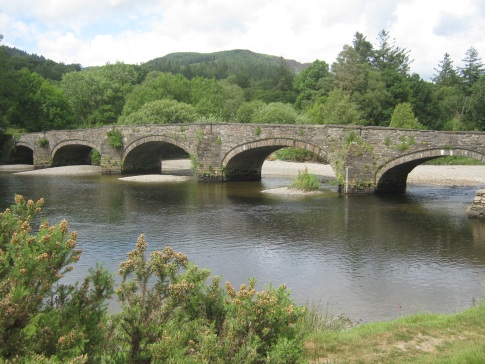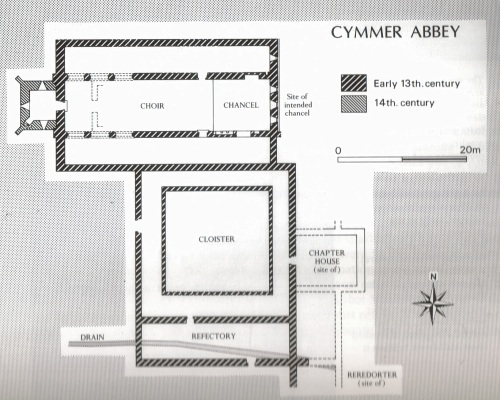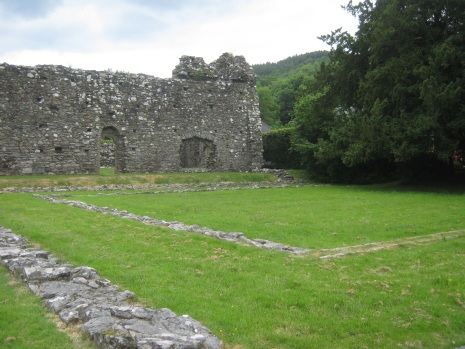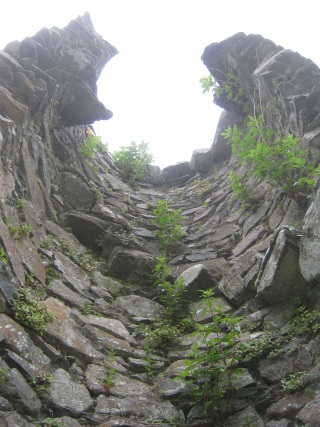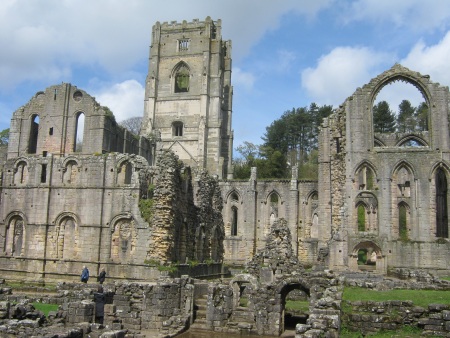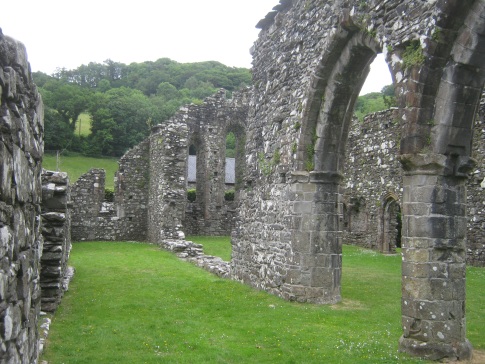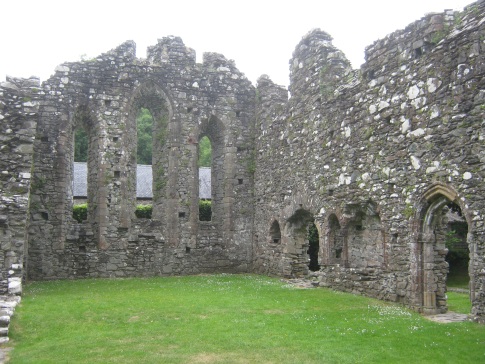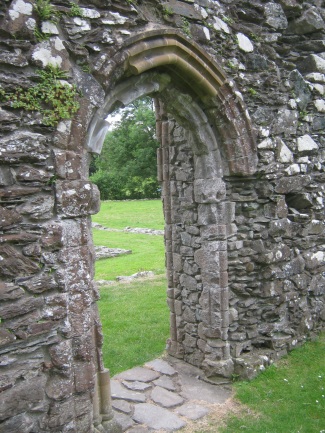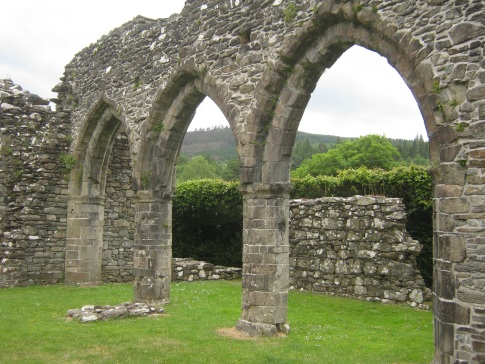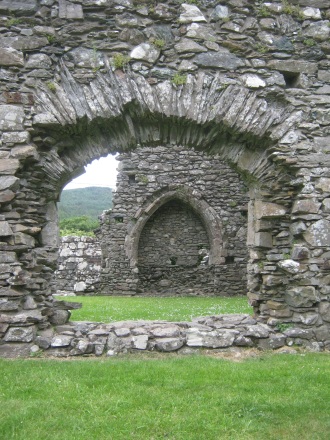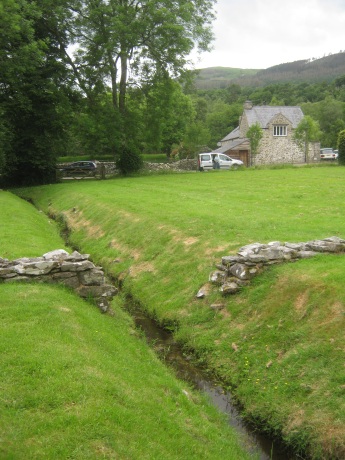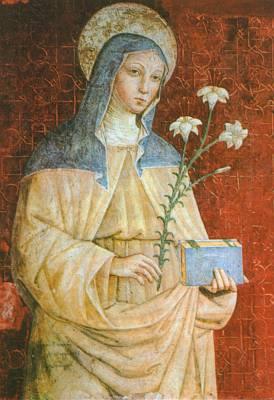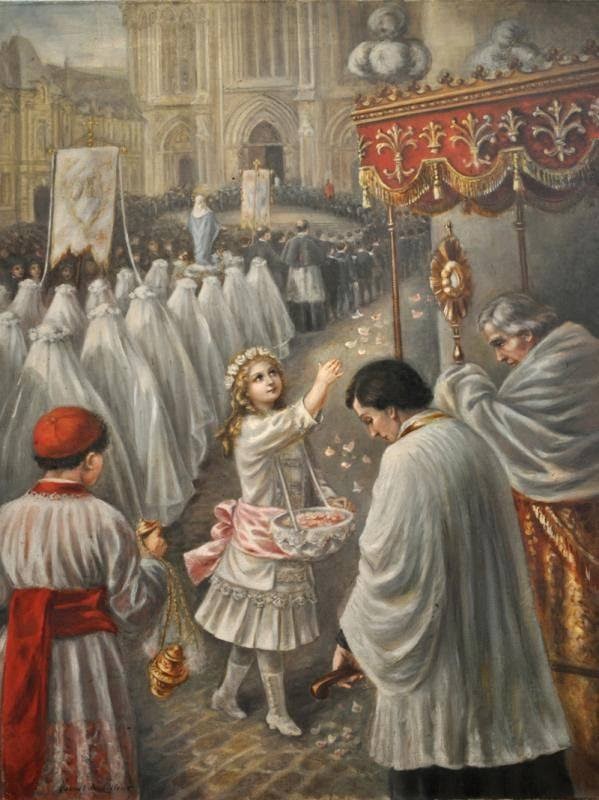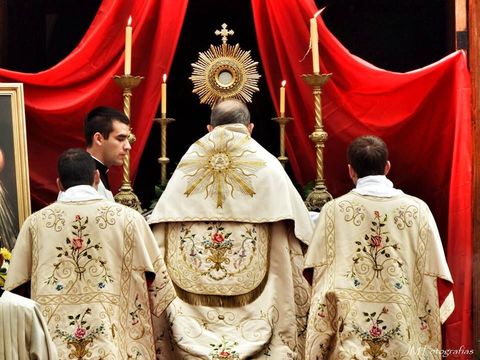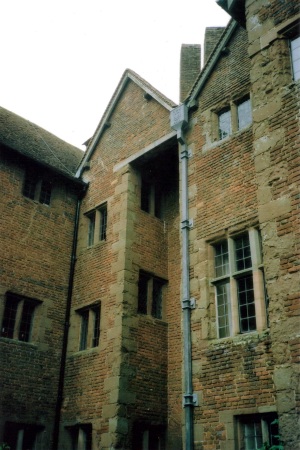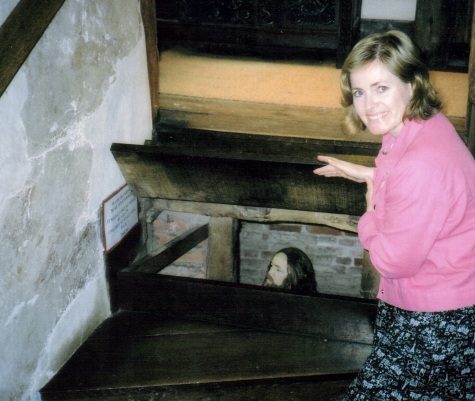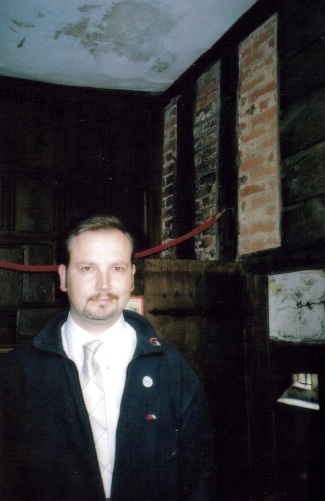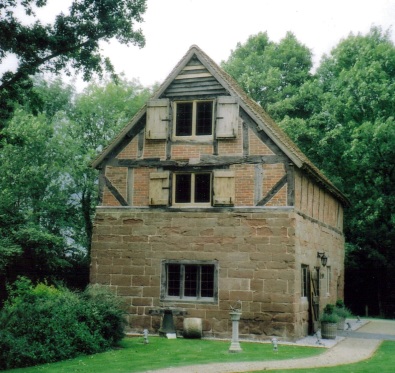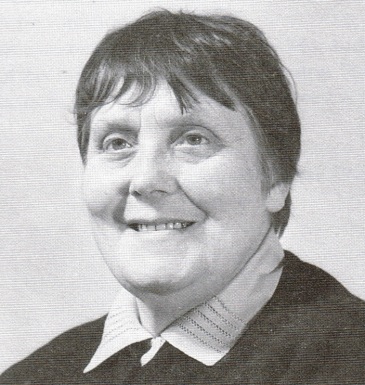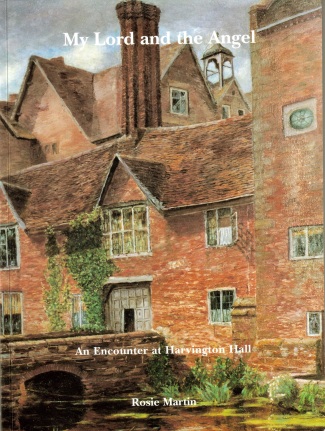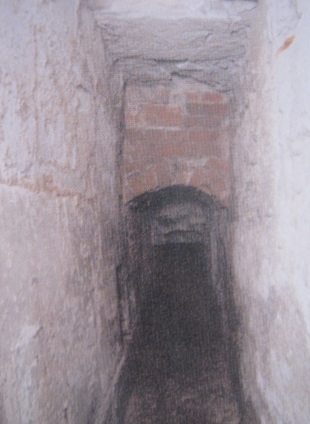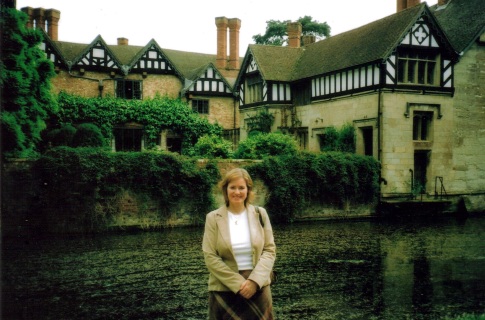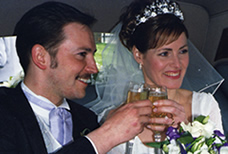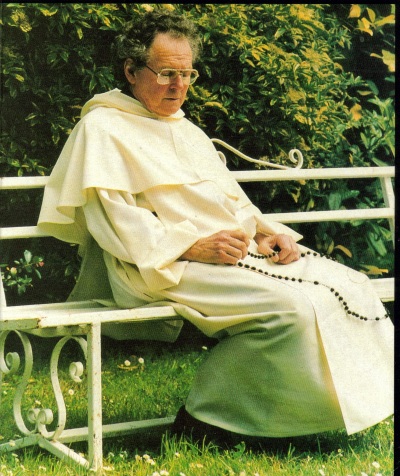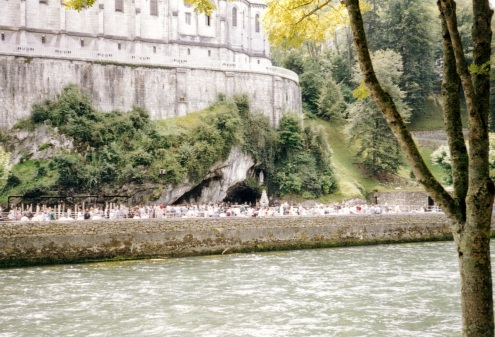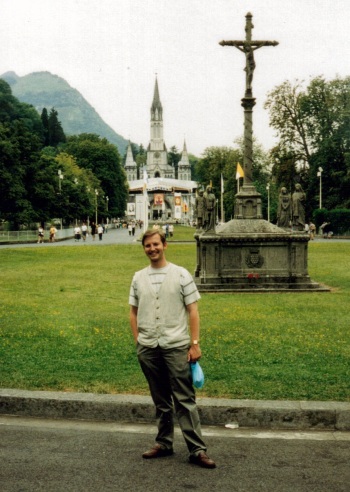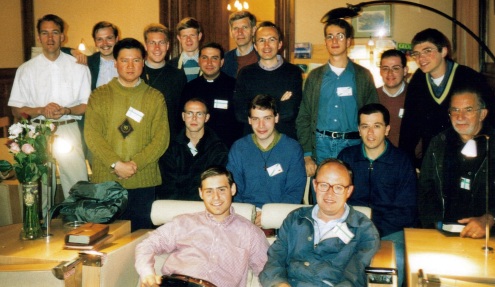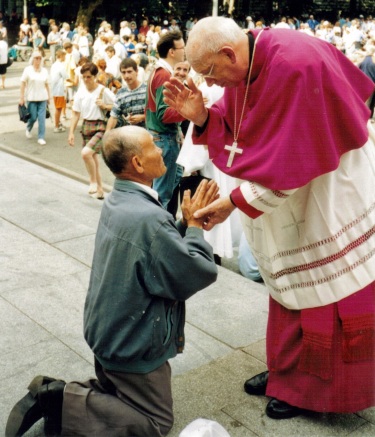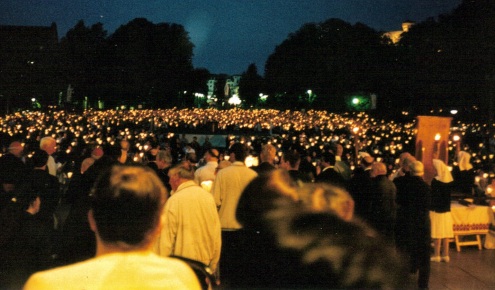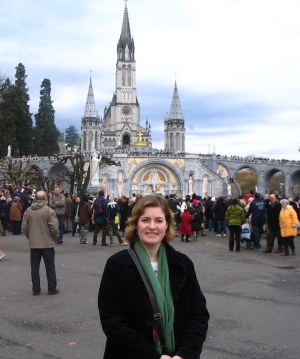Keep Your Eyes on Jesus!
 Torch of The Faith News on Tuesday 07 August 2018 - 14:49:44 | by admin
Torch of The Faith News on Tuesday 07 August 2018 - 14:49:44 | by admin
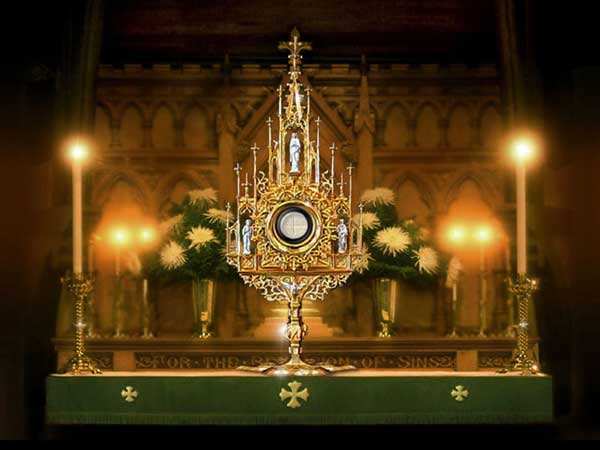
May the Heart of Jesus in the Most Blessed Sacrament be praised, adored, and loved with grateful affection, at every moment, in all the tabernacles of the world, even until the end of time.
Amen.
Offline...
 Torch of The Faith News on Tuesday 24 July 2018 - 00:32:34 | by admin
Torch of The Faith News on Tuesday 24 July 2018 - 00:32:34 | by admin
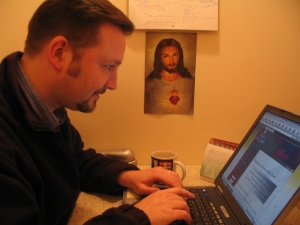
Alan ''Blogging for Jesus'' in the early days of Torch of The Faith, in 2008.
Dear readers,
Thank you for so kindly clicking by here each day.
I'm afraid that our laptop cable started crackling like a Guy Fawkes sparkler at the weekend.
That means that it is just far too risky to spend time on the laptop at present.
The good news is that the part is covered by our warranty. Not so good, is the fact that the delivery of a new one is going to take several days.
We did order the cable on Saturday, so we're already counting down the days, and I'm just zipping in here briefly to let you know that we're still around and OK.
Must dash, though, as we can only really rely on the battery for power. And, being an old laptop, that's not going to hold out for too long, without being connected to the mains electricity (there's a British saying for you!).
I hope to be back soon. In the meantime, let's keep one another in prayer and, above all: Keep the Faith!
God bless,
Alan.
Christus Vincit! Christus Regnat! Christus Imperat!
Merry Olde Wales - Cymer Abbey
 Torch of The Faith News on Wednesday 18 July 2018 - 19:30:05 | by admin
Torch of The Faith News on Wednesday 18 July 2018 - 19:30:05 | by admin
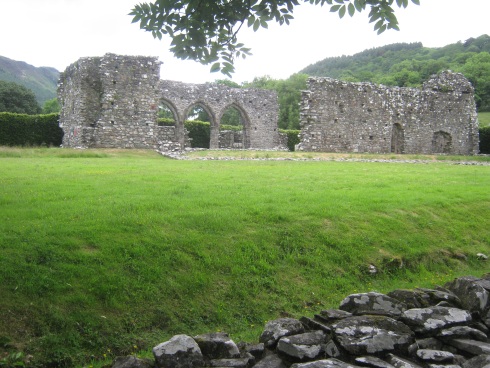
The remains of Cymer Abbey today: in typical Cistercian fashion, it stands in an isolated location in a secluded valley.
During our recent vacation in Wales, we managed to spend some time at Cymer Abbey, near the ancient village of Llanelltyd, and just northwest of Dolgellau. The name of the place can be spelt variously as Cymer or Cymmer, but in the interests of consistency, we will write of it here as Cymer.
The Cistercian abbey of St. Mary at Cymer was never a large or wealthy house, but it did have a long history.
In fact, the General Chapter at Citeaux received requests to build an abbey for the order, in both 1198 and 1199 AD, from a local prince of North Wales; a leader described as 'Grifin'.
Two extant versions of the ancient Brut y Tywysogion, (the Chronicle of the Welsh Princes), report the foundation of Cymer Abbey: the first speaks of a community coming there from Cwmhir Abbey; the second version suggests that it was the community from Cwmhir. Historians speculate that this may suggest that political instability led to the temporary removal of the entire Cwmhir community to Cymer.
In any case, although no foundation charter survives for Cymer, there is an extant confirmation charter of Llywelyn ab lorwerth; a cousin of the founder. In 1209, this affirmed the original endowment made by Gruffud ap Cynan, Lord of Meirionydd.
I love how that sounds like someone straight out of Tolkien's, Lord of the Rings!
Cymer was established on the eastern bank of the River Mawddach, near to its confluence with the River Wnion. Appropriately enough then, 'Cymer' means 'meeting of the waters'. I know I've already used this next picture recently, but it is so evocative of the peace of the place, that I thought it worthwhile including again. You could stand there and drink it in all day, really!
As I've said before, the present bridge is thought to date to the second quarter of the 18th-Century. However, records prove that there was a much earlier bridge near the site as early as the 1400's.
There are many places in the the UK and beyond in Europe, where local monasteries constructed and maintained bridges to facilitate local travel and commerce. This civilizing tendency was expressive of monastic charity to locals and travellers, as well as a useful source of income for the monastic community.
Cymer's proximity to these rivers gave the original monks fishing rights and access to the Irish Sea; thus facilitating communications with other monasteries and with the international trade in wool. As the Cistercians were expert sheep farmers, Cymer's location had much to recommend it.
In his expert study, Architecture of Solitude - Cistercian Abbeys in 12th-Century England, Peter Fergusson describes how local patrons gained both spiritual and temporal benefits from the endowment of a Cistercian monastery. Although his book deals with the situation in England, there are sufficient commonalities with that in Wales at the same time. And so, the primary benefit to a local patron, English or Welsh, would have been the Masses and prayers offered in perpetuity for the salvation of their souls, for those of their descendants and for their temporal welfare.
In that second instance, the endowment of a Cistercian monastery - something which was often cheaper to accomplish than those of other orders due to their insistence on poverty, simplicity and preferred choice of settlements in isolated valleys - would also bring local feudal lords access to new farming techniques and, importantly, an opening to the great sources of power in both Rome and Citeaux. In a place like Wales, with troubles from Kings of England, that could be a particularly helpful benefit at certain times.
If you are at all interested in Cistercian history, an author worth consulting is Janet Burton, Professor of Medieval History at Trinity, St. David at Lampeter, in Wales. Her book, The Cistercians in the Middle Ages - which was co-written with Julie Kerr and forms part of a series of books by various authors on the major religious orders in those times - provides an interesting, scholarly and largely sympathetic treatment of Cistercian history. I have also found Prof. Janet Burton's other text, a scholarly guide and comprehensive gazetteer called Abbeys and Priories of Medieval Wales, (this time co-written with Karen Stober of the University of Lleida, Catalunya), to be an absolutely invaluable resource during sojourns into Wales.
Professors Burton and Stober speculate that Cymer's proximity to the coast, combined with the aforementioned and typical closeness to the local feudal lord, may actually have brought not only commerical benefits to Cymer, but also political troubles.
As we've already established, Cymer was never a large or wealthy house, and it certainly looks to have suffered during times of social upheaval and war.
The plan of Cymer (depicted here with the alternative spelling of Cymmer) as it would have been when built. The community's poverty and paucity of numbers seem to have precluded the construction of the originally intended, and much more typically Cistercian, cruciform church. It is even possible that the West range of the claustral complex was never constructed either. Note the unusual tower at the west end of the church; and then see its remains in the second photograph below.
One of the more unhappy themes which crops up frequently in the histories of a number of the Welsh monasteries, most especially those closer to the disputed border with England, is the fact of damage and destruction being visited on them by opposing solidiers, or even just mobs of opposing feudal lords during periods of instability.
In 1241, still fairly early in Cymer's initial decades of growth, King Henry III's troops inflicted damage on the monastic buildings at Cymer. It seems amazing to modern ears to hear of Christian kings, often having founded monastic settlements of their own, permitting such evil acts. Such is the state of fallen human nature! More positively, the chronicles and records show kings at times making financial donations and gifts of reparation to monasteries in the years following such terrible attacks.
The records of the General Chapter at Citeaux report that, during the very year of the damage done by King Henry III's men to Cymer, the Cistercian leaders were so concerned at the reduced state of the place, that they considered dispersing Cymer's monks.
In the event, this does not appear to have been resorted to. However, in 1274, Abbot Llywelyn was finding himself too financially hard pressed to attend that year's General Chapter, until he was loaned some funds by Llywelyn ap Gruffudd, the latest in the line of Lords of Meirionydd.
There's that splendid Lord of the Rings sound again!
Lord Llywelyn actually made Cymer his base of operations in 1275, and again in 1279. However, it was the English King who made his regal headquarters there, during his Welsh campaigns, in 1283!
For all its troubles, the abbey was compensated with the sum of £80. However, when Pope Nicholas IV's Taxatio ecclesiastica, made its official enquiry into the taxable assets of all religious houses in 1291, Cymer's income was valued at just over £23.
The claustral ranges are no longer extant at Cymer, however their plan remains helpfully marked out in stone. This view looks towards the church from the south-western corner of the cloister complex. In the black and white plan image further above, that would be situated in the bottom left hand corner of the cloister square.
By 1379, just four monks were still trying to live the Cistercian life at Cymer. I say ''trying to'' as it would have been difficult for such a low number to maintain the daily monastic horarium and to run the buildings and land. Cistercian statutes from the era called for a community of twelve men with a prior and additional lay brothers. Later, in the mid-15th-Century, the income at Cymer fell so low that the monastery needed to be taken into royal custody a couple of times.
As the caption to the plan image of the monastery's buildings mentions above, this paucity of members and poverty of income caused Cymer's original building plans to be somewhat curtailed.
Colin Platt, a thorough historian of the Middle Ages, and former chair of Medieval History at Southampton University, notes that the wars in Wales caused Cymer to lack both the originally intended, and far more typically Cistercian, presbytery and crossing of what, would then have been, a cruciform church. Indeed, unable to complete their building on the model of many larger Cistercian houses of the period, Cymer's community had to worship in the lay brethrens' choir; this was more normally a separate area.
It also seems probable that the construction of the west claustral range, the usual preserve of the lay brethren, was omitted altogether. In larger houses, it was the lay brethren who not only occupied the west claustral ranges and western end of the nave of the cruciform churches, but who also carried out the bulk of the manual and agricultural labour. This was one aspect which had made the Cistercians such a driving force in monastic growth and reform in these lands.
As our pictures show, in spite of the cruel Henrician depradations of the 16th-Century, and the centuries of decay which have passed since then, there are sufficient remains of Cymer to allow inspection, reflection and even silent prayer.
Aside from a helpful illustrated sign giving a brief overview, there is not much interpretive data at the site today. However, with sufficient wider reading, and the help of Professors Burton and Stober's handy gazetteer, one can piece together the basic set up which would have been established and handed on for centuries at Cymer Abbey.
The gazetteer confirms Colin Platt's theory, itself reliant on a key text called simply (by the alternative spelling) Cymmer Abbey, written in 1946, by C.A. Ralegh Radford, that the church was never completed with its initially projected transepts to make a cruciform plan.
Their gazetteer points out that this also meant that a planned central tower was never implemented. However, it also speaks of an unusual western tower being added in its place.
On the day that we visited, I took this photograph looking skywards through, what I took to be, the remains of that western tower. Certainly, this was present in the western end of the remains of the central church.
Towers were originally heavily restricted in the earliest statutes of the Cistercians, due to the order's theological and mystical desire for simplicity. As the centuries progressed, Cistercian towers did creep in; eventually culminating in the kind of architectural wonder presented, around 1500 AD, by Abbot Huby's magnificent tower at the once-wealthy Fountains Abbey in Yorkshire.
A quick aside to show you Abbot Huby's great tower at Fountains Abbey in Yorkshire. We visited the enormous remains of Fountains in April, 2012; in order to renew our wedding vows at the site of the old High Altar, on our 10th wedding anniversary.
Although Cymer was a poor and small monastic community, the monks still managed to construct a reasonably sized church, with an aisled nave. This next image was taken standing in the northern aisle looking towards the eastern end of the aisle and church.
A neat thing to notice here, is how, in the present day, an arch has been formed in the trees on the valley side above the church, due to a clearing which has been kept to allow electricity lines to come down that side of the valley. As you probably know, this kind of setting in an isolated valley, often close to healthy woodland and river systems, is a classical hallmark of the typical Cistercian monastic settlement.
Colin Platt suggests that, being constructed on a small scale, the choir monks at Cymer would, unusually, have worshipped in the lay brethren's choir.
Moving through the extant medieval arches, we enter the church proper and stand here looking to the east end of the church. Notice the three fine and tall, but simply executed, Lancet windows. Being a poor house, it seems that Cymer did not develop the structure with the kind of splendid tracery which eventually crept into and replaced the simple architecture of the wealthier houses. Â
Other things worth noticing, include, what looks to me to have been the original sanctuary piscina niche, in the south-eastern corner, (to the right of the eastern window wall, but to the left of the arched doorway in the picture), and also some blind arcading to the right of the far doorway.
I always like to try and imagine where the original High Altar would have stood in these ancient monastic sites. Here we have moved in slightly closer towards the sanctuary end of the remains of the ancient church.
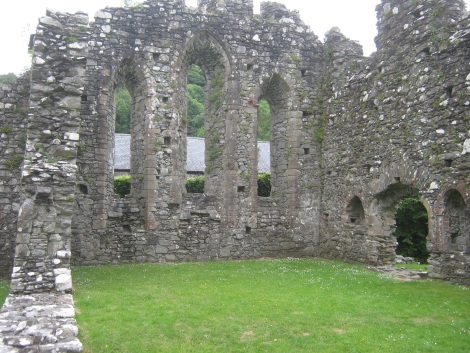
After taking this photograph, I moved right on in to where the Altar seemed most likely to have stood. I prayed there in silence for a while. Although there is a working farm next to the site, and a small holiday camp to the other side, there is a pleasant peace at Cymer Abbey anyway. Nevertheless, the peace that came when praying in that east end was intense. It is amazing to think of the Holy Mass and Divine Office being offered, right there by dedicated monks, on so many days, through all those centuries from the foundation in 1198, right through to the Henrician suppression in 1538. That means that a lot of grace came down in that place, and for a very long time. No wonder it remains peaceful to this day to those who stop to pray, listen and sense interiorly in the silence.
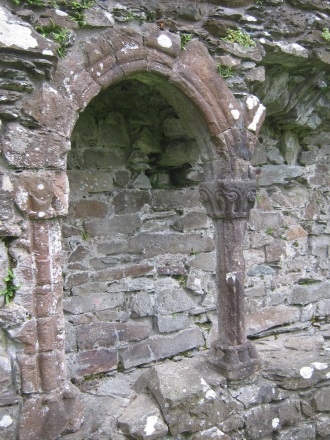
Here is a close-up of that blind arcading close to the sanctuary area. It has stood up reasonably well to centuries of the sometimes testing weather in the Snowdonia region. The site is owned and looked after today by Cadw, the Welsh governing body of protected sites.
The remains of this fine archway would originally have linked the church through to the cloister and claustral complex, to the south of the church. On the grass just beyond, the stones marking out the lines of the cloister can be seen. That claustral complex of buildings would have been centred on this cloister and would have included the chapter house, refectory and dormitory. Larger houses eventually built their refectories on a north-south axis, but it seems that Cymer's was in the east-west axis; something that had been typical in many places early in the Cistercian expansion, but had been superseded as the houses of the order gained more members and resources.Â
The standing arches at Cymer are fantastic and it is incredible to think of their historical provenance. In the present day, it is refreshing to stand there and look up to the trees on the surrounding hills.Â
Here is an interesting set of archways; through which one can stand and wonder what might have once been, and indeed what could be again some day.
If you know anything about Cistercian history, you will know that they were experts at land clearance and water management techniques. At Fountains in Yorkshire, one can still see how the monks canalised the River Skell and constructed their kitchens, refectory, dormitory and infirmary in such a way as to make use of the rapidly moving waters for cleaning and drainage. Some Cistercians were also talented makers of ornate taps which fed channelled water into troughs for washing etc.
As with so many things, Cymer's use of water was rather more modest. However, if you look back to the plan near the top of this article, and compare it to the following photograph, it is still possible to see how the original drainage fed straight through under the refectory and reredorter (dormitory).
Here we are to the south of the claustral complex plan looking westwards along the brook. Notice the stones of the old plan of the monastic site crossing the brook. That's our silver wheelchair adapted vehicle in the distance!
You'll also notice the farm house to the right. I've mentioned that Cymer is on the edge of a working farm today. Professors Burton and Stober point out that the extensively restored farm house to the west of the site preserves timber from what was probably an impressive hall. This has been dated to 1441 or soon after by the process of dendro-chronology. As such, the original hall could have been an abbot's lodging, or maybe a guesthouse.
In the early days of the Cistercian reform in the UK, the abbot slept in a niche, or separate room, close to the dormitory. However, as abbeys grew wealthy through land management and agriculture, their abbots became more and more powerful as landowners, and thus increased in temporal status in a way parallel to local feudal lords. To match their heightened status, they constructed ever more ornate lodges at the edge of the monastic sites.
These lodges, which in one or two places had actually reached the grandeur and scale of mansions by the 16th-Century, were used to entertain important guests and benefactors.
Of course, as we have reflected here many times, the monastic world came to an abrupt and cruel end in the 1530's, when King Henry VIII suppressed all of the 800 or so monasteries which were still functioning at that time. Thus bringing to an end a whole empire of prayer, adoration, thanksgiving, intercession; as well as a world of social ordering expressed through the giving of the sacraments, kind acts of charity to pilgrims and travellers, care of the sick and dying, provision of food and supplies to the poor, offering of education, provision of security for deeds, documents and money, and management of land, water and commerical interests.
It is interesting to notice how the attack on the monasteries, and the essential monastic prayer that issued from them, came from without in the 16th-Century.
In our day, after almost five further centuries of associated religio-cultural deformation, the attack on the always-vital monastic life is now coming from within.
I've said before that, although it is possible to overstate the case, there really was once a merry olde medieval world, which developed as the fruit of a genuinely Catholic Christendom.
Having already and rhetorically asked here before, whether the UK was ever so merry again after our nation lost the Catholic Faith, let us conclude with some moving words from the end of Colin Platt's engaging book, The Abbeys and Priories of Medieval England. Whilst including quotes with the spelling from old English, it also gives food for thought in terms of the present-day depredations which have been described above; depredations which need to be resisted.
''In the meantime, though, a sense of desolation had developed. Shakespeare writes of those 'bare, ruined choirs where late the sweet birds sang'; Donne of the winds which 'in our ruin'd Abbayes rore'. In humbler but no less poignant vein, Francis Trigge would report in 1589: 'Many do lament the pulling downe of abbayes. They say it was never merie world since.'''
Well, I say we need to make the Church and the world merry once again: Stand up for the true nature of religious life and defend the holy nuns, monks and consecrated virgins who live the religious life, as the very heartbeats at the centre of the Church's life. May we not fail them, as did our forefathers in the 16th Century.
St. Mary, Patroness of Cymer - Pray for us!
Corpus Christi 2018
 Torch of The Faith News on Thursday 31 May 2018 - 11:05:10 | by admin
Torch of The Faith News on Thursday 31 May 2018 - 11:05:10 | by admin
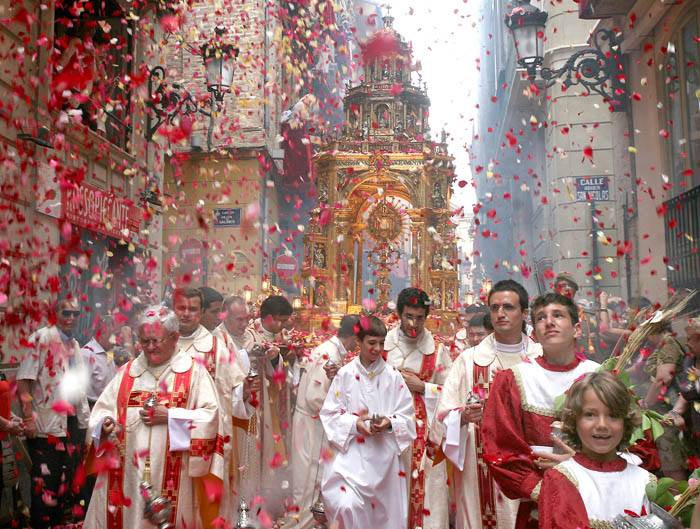
The great feast of Corpus Christi, on the Thursday after Trinity Sunday, was introduced in Flanders about 1246 AD. In 1264, Pope Urban IV extended the feast to the whole of the Universal Church. He was moved to do this by a miracle at Bolsena, when the Real Presence of Our Lord in the Eucharist, Body, Blood, Soul and Divinity, was visibly demonstrated to a doubting Bohemian priest. The composition of the splendid prayers, hymns and lessons for the feast were entrusted to the great Angelic Doctor, St. Thomas Aquinas. In the later Middle Ages, Corpus Christi came to be celebrated with ornate processions and expositions. It became a great demonstration of Christian faith.
I've explored before the fact that, in the days before Christendom was sundered by the Protestant Revolt, Christian civilization was notable for its deep cohesive unity.
Although the fallen nature of humanity and the reality of spiritual warfare meant that this unity was never perfect - and this is illustrated by the fact that a riot broke out at the Corpus Christi procession in Chester during 1399 AD, as well as the establishment of an ordinance at Newcastle in 1536 to avoid murderous discord between the Craft Guilds in the religious processions! - it was also the case that the underlying spiritual and civilizational unity was profound and widespread.Â
And so, the Most Holy Eucharist at the heart of existential reality brought unifying harmony in the realms of: the heart and the mind; the body and the soul; man and woman; parents and children; the family unit and wider society; the individual and the local community; the local community and wider society; Scripture, Tradition and Magisterium; the bishop and his priests; the priest and his people; the parish, the diocese and the Universal Church; the Church in Heaven, Purgatory and on Earth; the Church and the State; public and private devotion; culture and nature; leisure, prayer and work; faith and works; the calendar and the seasons; the ailing and the physically healthy; the living and the dead.
At the source and summit of all of these deep unities was the underlying Real Presence of Our Lord and Saviour, Jesus Christ, in the Most Holy Eucharist. By His Incarnation, and the continuation of His Crucified, Resurrected, Glorified and Ascended Real Presence in the Blessed Sacrament, Our Lord brought the most profound and foundational unity of all: that of the unity between God and man.
Before the Reformation, Catholics ''ate into'' this religious mystery at the heart of all things, with the whole of their body and soul expressing their belief, as parts of a corporate body; indeed as members of the Mystical Body of Christ. In unity, they prepared, they confessed, they sang, they processed, they prayed, they knelt, they adored and they ate.
Alas, the Protestant Revolt sundered each of these deep unities. After this tragic event, Christians were ''fractured out'' into Protestant ''churches'' as groups of individuals who now merely assented to certain key beliefs with their intellects. This reductionism, playing down the corporeal dimension of religous worship and experience as it does, is a key moment in the descent into extreme rationalist positivism. Gradually, even those key beliefs broke down into disharmony, with the result that disparate groups of individuals assented to often opposing sets of beliefs. In time, only the individual and their own unique self-assertion of their personal belief and will, came to impose itself.
In public and private worship, and thus in daily life, the lone intellect, with all of its limitations, weaknesses and sinfulness, had become radically sundered from the body of both the individual and the corporate body of the faithful. The post-modern confusion and isolation of our times is merely the latest stage of this unravelling. Even in the Catholic Church, in too many places in recent times, a similar minimalism in liturgical belief and practice has led to a related diminishment and harrowing of the faithful.
This is one reason why it is absolutely essential for Catholics to remain rooted in the Holy Eucharist at the heart of the Church. As St. Padre Pio used to say: ''Always remain close to the Catholic Church, for She alone can give you Jesus Christ in the Blessed Sacrament.''
Let us take forward and conclude today's article with a marvellous reflection from that great saint of the Holy Eucharist, the founder of the Blessed Sacrament Fathers, St. Peter Julian Eymard.
He wrote:-
To the testimony of her word, the Church adds the testimony of her example and practical faith. As St. John the Baptist, after having pointed out the Messiah, cast himself at His feet to prove the liveliness of his faith, so the Church devotes a solemn worship, her entire worship to the adorable Person of Jesus Whom she manifests to you in the Most Blessed Sacrament.Â
She adores Jesus Christ as God, present and hidden in the Divine Host. She pays Him the honour due to God alone; she prostrates herself before the Most Blessed Sacrament like the heavenly court before the majesty of God.
Distinctions of rank are not in order here: great and small, kings and subjects, priests and people instinctively fall to their knees before the God of the Eucharist.
It is the Good God!
The Church is not content to attest her faith by adoration alone; to that she adds public and magnificent honours.
The splendid basilicas are the expression of her faith in the Most Blessed Sacrament. She did not wish to build tombs but temples, a heaven on earth in which her Saviour and God might find a throne worthy of Him.
With a delicate and jealous attention the Church has regulated Eucharistic worship to its minutest details. She does not rely on anyone to take in hand the matter of honouring her divine Bridegroom; for everything is important, is significant, and divine, when there is question of the Real Presence of Jesus Christ.
She wants to consecrate to the royal service of Jesus all the most genuine and precious things in the world.
In her liturgy everything is related to this mystery; everything takes on a spiritual and heavenly meaning; everything has a property of its own and contains some special grace.
How easy it is for the soul to recollect herself in the solitude and silence of a church! A gathering of saints on their knees before the tabernacle causes us to exclaim: ''There is more than Solomon, more than an angel here!'' Jesus Christ is here before Whom every knee bends, of those that are in Heaven, on earth, and under the earth.
In the presence of Jesus Christ in the Most Blessed Sacrament, all greatness disappears, all holiness humbles itself and comes to nothing.
Jesus Christ is there!Â
Panis vivus et vitalis! Bread which lives and maketh live!
To which, we can only add: And we love Him! Amen.
Let us Love and Adore Him in the Holy Eucharist on this very special day. We wish every blessing,grace and joy appropriate to this feast to our readers today!Â
What Was Ancient and Abandoned, You Shall Rebuild
 Torch of The Faith News on Monday 21 May 2018 - 12:37:31 | by admin
Torch of The Faith News on Monday 21 May 2018 - 12:37:31 | by admin
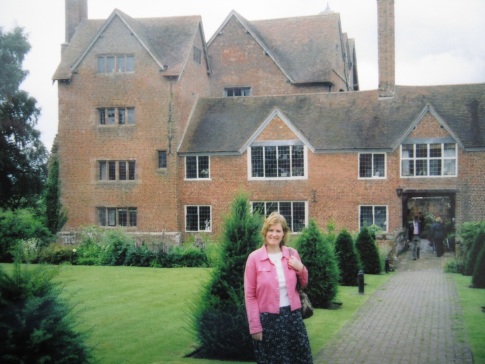
Angeline at the front elevation of the remarkable Harvington Hall, near Kidderminster.
Another Amazing Catholic Manor House
On Friday, we were considering the inspiring Catholic history of Baddesley Clinton manor house near Warwick. We thought that it would be good to follow that piece up with a similar one about the large and fascinating Harvington Hall.
Harvington Hall is another moated manor house, which stands approximately 25 miles to the west of Baddesley Clinton. It is worth studying, because it contains the finest surviving series of priest-holes in all of England.
A Masterpiece of the Genius of St. Nicholas Owen
First constructed in the 1580's by Humphrey Packington, the vast, moated manor house of Harvington Hall allows a unique insight into the creative genius and skill of St. Nicholas Owen.
As we mentioned in Friday's article on Baddesley Clinton, St. Nicholas Owen was a Jesuit lay brother and carpenter, who constructed secret priest-holes in the houses of recusant Catholic families all over England.
These were necessary to provide shelter for Catholic priests from raiding pursuivants, during a time when it was high treason, punishable by hanging, drawing and quartering, to be a Catholic priest operating within the realm of Queen Elizabeth I. Even those who shielded priests could be executed.
Four of the intriguing hiding places at Harvington Hall bear the hallmarks of St. Nicholas Owen.
Given the extent of the work involved at Harvington Hall, it seems a fair conjecture to us to say that the original designs for the central Great Staircase, and therefore of the entire house itself, would always have been structured around the provision of hiding places and the secret access places built into them.
That would mean that, unlike in other places where St. Nicholas Owen needed to apply his lateral thinking and carpentry skills to create hiding places within already existing structures, the original planning for Harvington Hall could have been one in which the form of the whole house would follow the function of sheltering priests. As such, it would be a kind of ''priest-hole designer's dream house'' for him to enjoy exercising his creative genius. It is an interesting theory.Â
Be that as it may, the construction of Harvington Hall provided St. Nicholas Owen with an unprecedented opportunity to develop a series of very sophisticated priestly hiding places.
Stairway to Heaven
Cross-section drawings of the sprawling Harvington Hall reveal an ingenious series of hidden passageways, leading on to various secret hiding places. Though disparate, each of the unique hides is situated around the central structure of the Great Staircase.
Angeline lifts one of the main stairs to reveal a hiding space for Catholic priests on the run from priest-hunting pursuivants. As you can see, the curators have provided a mock-up of their very own Elizabethan-era priest, kneeling in prayerful supplication in the ''priest-hole''.
As Angeline demonstrates here, one of the main stairs is hinged and can be lifted up to reveal a small hidden room within the staircase proper. The position of the wax-effigy of a hidden priest kneeling in prayer, gives some idea of the amount of space available to someone hiding there. It is not a bad space, considering that some pursuivant raids could last for hours, or even days if the raiders stubbornly remained on or near to the premises.
A few steps higher than this one, two angled treads hinge upwards to provide a small triangular hide. In his informative book, How We Built Britain (2007), which was based on his BBC TV-series of the same name, David Dimbleby suggests that this little hiding place could have contained jewels and some money. However, we think that the historian Alice Hogg may be rather closer to the mark, in her captivating narrative history God's Secret Agents - Queen Elizabeth's Forbidden Priests and the Hatching of the Gunpowder Plot (2005), when she conjectures that the books and equipment for Holy Mass would likely have been stored here.
A Clean Sweep
The young, as well as the young at heart, will likely love the ingenious false fireplace in Harvington Hall's Marble Room.
A carefully spread layer of soot would likely have fooled most observers into thinking that this was just a regular brick fireplace. However, it is not real; stairs up inside the false chimney lead on to a hidden passageway in a maze of attics. There are two hides within these attics; one of which was situated behind a false wall, behind which as many as a dozen adults could safely hide.
Lost in a Book
So well concealed are St. Nicholas Owen's hides at Harvington that one of them was only discovered by accident in the late 1890's.
At that time, the hall had fallen derelict and some young boys had ventured into the empty and damaged building to play. One of them, having climbed up into a space in Dr. Dodd's library, fell against an upright beam. This suddenly pivoted upwards to reveal a further narrow hiding place of eight feet in length, five feet in height and three feet in width.
Closer inspection eventually enabled further understanding of St. Nicholas Owens' giftedness; for inside was a specially constructed stool, too wide to have been pushed into the narrow space, which must have been carved outside, and then assembled in situ, to allow a little rest to any weary priests who might have been forced to hide within the tight confines of that particular hide during the Elizabethan persecution.
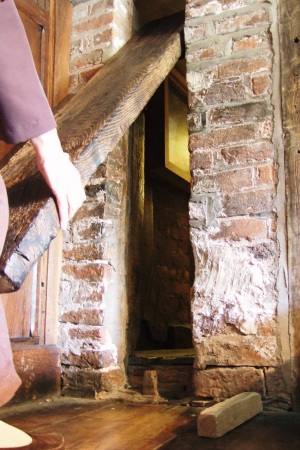
Whilst this image shows the pivoting beam being raised to reveal the inner space, the picture below shows that this beam is itself high up on a raised platform. During Elizabethan times, the place that is now marked below with a red rope would have been covered with book-cupboard doors and removable wooden shelves would have been placed within. Should raiders have arrived at the front door of the hall, any hiding priest could have scrambled up through the cupboard and been hastily installed behind the pivoting beam; whilst assistants could have quickly assembled the facade of the bookcase, inner shelves and, no doubt, a selection of books, across the frontage. It would thus have been an excellent, if rather stuffy and restricted, hiding place!
Catholic Mirth
You there! Stop smirking, straighten your tie and pay attention. That way, you might actually learn something! Behind you is a raised platform with a red rope. That would originally have been covered with a false bookcase. To the right of the red rope is the upright pivoting beam, which leads into the narrow priest-hole within.
I must say that I was chuckling all the way round Harvington Hall when we visited the place several years ago. This is because there is something of that truly Catholic quality of joyful mirth in the constructions there. G.K. Chesterton was on to something when he said that angels can fly, because they take themselves lightly.
I would say that, even though the dangers faced by priests, recusant families and their servants in those times were extremely grave, there is nevertheless something tongue-in-cheek about St. Nicholas Owens' hiding places. I bet he had a deal of fun designing them!
The various hides at Harvington, including also later additions such as the lifting floor panel in the high chapel, the wide space in the kitchen shaft and the great loft hide, have something about them which calls to mind the fast witticisms, and more importantly the underlying charitable kindness, displayed by some of the martyrs as they were led out to die for Christ and the True Faith on the scaffold.
As an enclosed nun once explained to us during a tour of the martyrs' museum at Tyburn Convent in London, it was the charity and forgiveness of the martyrs at their unjust trials and deaths which makes them such valuable witnesses down to the present day. Like Christ, they mercifully prayed for the ultimate salvation of their enemies. What a deep prayer life those martyrs must have cultivated.
Subsequent History
Dr. Dodd, for whom the library was named, was actually a pseudonym of Fr. Hugh Tootell, who lived at the hall and wrote a church history in that room during the 1700's.
Out in the grounds is the marvellous Elizabethan Malt House. The lower sandstone and upper brick-timber has been reconstructed to appear as it would have done in its heyday.
The interior houses a restored 18th-Century malting kiln and now features modern educational technologies and resources.
There is also a restored Georgian-period chapel in the grounds at Harvington Hall. By that era, anti-Catholic persecution had certainly subsided in England, at least in its most virulent forms. Nevertheless, Catholics still ''kept their heads down'' so to speak. As such, the chapel is camouflaged by two parallel walls, running at 10ft in height between the chapel and courtyard, to provide discreet access, thus sheltered from any prying eyes which may have been watching from the nearby fields.
My Lord and the Angel
If you are interested in learning more about Harvington Hall, we recommend Rosie Martin's enchanting book, My Lord and the Angel: Encounter at Harvington Hall (1997).
As a small child growing up in the 1920's, Rosie had wandered into the, then, largely derelict Harvington Hall. During her secret visit, she had encountered the other-worldly Archbishop Edward Isley of Birmingham, who was then living in part of the hall, and his devoted sister. As the venerable Archbishop was being addressed as ''My Lord'' by the old lady, the infant Rosie imagined in her innocence that this mysterious figure must be God.
In a manner which is at once down-to-earth, and yet also deeply mystical, Rosie's book touchingly recounts her lifelong journey, from her subsequent childhood conversion and reception into the Catholic Faith until her life as a Catholic lady of mature years and outlook.
The consistent theme at the centre of all her varied experiences, and of her deepening understanding and spirituality, is always that sense of enchantment and encounter which she first received as a little girl in Harvington Hall.
Handing on the Legacy
As our article has already twice alluded, Harvington Hall had fallen into a largely derelict condition during the 19th and early 20th-centuries. Incredibly, the original Central Staircase was removed and taken to Coughton Court in 1910.Â
Coughton Court has its own remarkable recusant Catholic history. Indeed, in 1858, a cleverly concealed priest-hole was rediscovered in the Tower Room there. Again, when Coughton Court was fully opened up in 1910, the priest's hiding place was found to contain a rope ladder, small tapestry, bedding and a folding altar, made from leather.
As a double-hide, this meant that, even if pursuivants had discovered the outer space, they would have been unlikely to make the further discovery of the second, deeper priest-hole within.
However, Harvington Hall is itself now restored, owned and run through a trust by the Catholic Archdiocese of Birmingham.
The central stairway, complete with hides, was carefully recreated on site to provide this important window onto such an important period of English Catholic history.
As was the case with Baddesley Clinton, we highly recommend this manor house as a place for prayerful reflection on the legacy of the English Martyrs and the truths of the Catholic Faith.
Visitors today can also enjoy a pleasant tea-room, a decent souvenir shop, walks in the lovely grounds and a visit to the herb gardens, which have been recreated in the style of those from the Elizabethan era.
Looking Back to Go Forward
The title of our article today is taken from Isaiah 58, which graces the heraldic mantel in the fully restored and wood-pannelled Great Chamber at Harvington Hall. In Latin it reads: Aedificabuntur in te deserta saeculorum. In English, that is rendered as, What was ancient and abandoned, you shall rebuild.
As well as being an apposite motto for the resurrected Harvington Hall, pointing beyond itself to that of Our Lord and Saviour, Jesus Christ, we also think it very apt for Catholics striving to remain faithful and, by the help of God's grace, to restore the Church in our own days.
Although no priests were ever captured from Harvington Hall - the hides were that good! - the martyr-priest St. John Wall did live and work there for several years. And, of course, there is the very tangible link, through his own planning and work, to St. Nicholas Owen himself.
Prior to his own capture and martyrdom in 1606 AD, St. Nicholas was actually starved out of one of his own hides over at Hindlip House. Sadly, Hindlip was demolished in 1815, but extant descriptions of the series of hiding places there reveal striking similarities to those of Harvington.
Harvington Hall is also a good place to pray, because of the fine Small Chapel; enhanced as it is by the wall paintings from around 1600 AD, which depict red and white droplets to call to mind the Blood and Water flowing from the Heart of Christ at His Sacred Passion.
The courage, ingenuity, love and faith of the English Catholic martyrs and recusants can still teach us a great deal in the difficult times through which you and I now live. They kept the light of the Catholic Faith burning here in England, through dark centuries when the Holy Sacrifice of the Mass and the Sacred Priesthood were outlawed under extreme penalties. When the Faith was gradually allowed to return, through the changing flux of history, and the massive influx of Catholic immigrants through the Industrial Revolution and the Irish Famines, there were found a few who had never lost the Faith of Our Fathers, and who had kept practicing the Faith in hidden places throughout all of those difficult centuries.
One could even posit that the graces won by these heroes paved the way for the many thousands who were received into the Catholic Church in Great Britain between the 1850's and 1950's; a heritage which has been largely squandered in the decades following the Second Vatican Council.
May the witness and prayers of the Holy Martyrs and recusants help us to be inspired and to Keep the Faith!
Holy martyrs of England and Wales - pray for us!  Â
Worldly Glory is Transitory, but the Catholic Faith Endures
 Torch of The Faith News on Friday 18 May 2018 - 10:06:41 | by admin
Torch of The Faith News on Friday 18 May 2018 - 10:06:41 | by admin
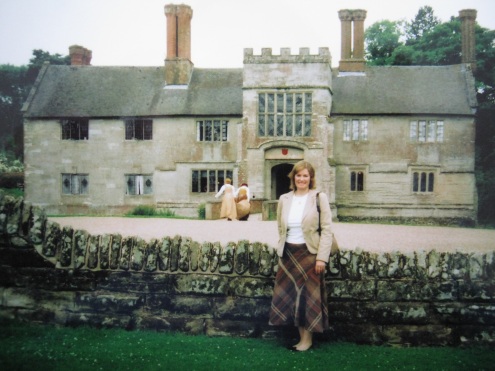
Angeline maintains a camouflaged look-out for pursuivants outside of the historical Baddesley Clinton manor house!
Remembering the Catholic Martyrs
We reflected yesterday on the need to remember the faithful witness of the Catholic martyrs who died for the Holy Sacrifice of the Mass and the One True Faith, which was established by Christ for the salvation and sanctification of souls until the end of time.
As an aid to this kind of remembrance, it seems a good time to re-post an updated version of an article on the English martyrs, which first appeared here in the summer of 2015.
Baddesley Clinton Manor House
The moated manor house of Baddesley Clinton, in the pleasant area 8 miles to the north of Warwick, is steeped in Catholic history.
The house is thought to originally date to the 13th-Century. During the 1400's, one of the owners is said to have murdered the local Catholic priest in the house. By God's grace, he repented of this sacrilegious crime and did penance by extensively restoring the local parish church of St. Michael. In that era of the Late Middle Ages, Baddesley Clinton was a moated manor, which was fortified with gunports and a draw-bridge over the moat. To this day, the moat remains to the rear of the property.
Through marriage, the house passed into the Ferrers family in 1517. In the 1590's, during the era when English Protestantism gained its hegemony over the populace, Henry Ferrers leased the property out to two strongly Catholic recusants: Anne Vaux and her widowed sister, Eleanor Brooksby.
In this period, the state had become extremely hostile to the Catholic Church and to those who continued to practice the ''old'' True Faith. The machinery of the Elizabethan persecution had driven the Catholic Church underground; outlawing the Sacred Priesthood and the Holy Sacrifice of the Mass, whilst inflicting heavy penalties on those who refused to attend the Protestant supper services.
Catholic priests who were discovered in the realm, together with those who directly sheltered them, could face torture and execution. By the end of Queen Elizabeth I's reign, some 123 Catholic priests and over 60 lay people had been executed. Countless more had endured imprisonment, heavy fines, mockery and social exclusion for keeping the Faith.
Clearly, Anne Vaux and Eleanor Brooksby were running huge risks when they began to shelter priests and allow the Baddesley Clinton manor house to be used as a venue for secret offerings of the Holy Sacrifice of the Mass.
We must remember that those risks were heightened by the fact that the Elizabethan government actively pursued priests and their accomplices by the use of a network of spys and infamous priest-hunters like the diabolically cruel torturer, Mr. Richard Topcliffe.
Jesuit Missions
These two good sisters were not the only ones running high risks at Baddesley Clinton.
Scattered at secret locations throughout the country were a number of Jesuit mission priests, under the prudent leadership of Fr. John Gerard, SJ. The dangers they faced made it necessary for them to endure long periods of isolation from their Jesuit brethren.
Once every two years, the Jesuits would come together for a clandestine conference. These biannual meetings had both spiritual and practical purposes. They provided mission priests with a forum to discuss strategy, make future plans and share important information and news. More deeply, they enabled them to make their confessions, receive ongoing formation in the sophisticated Jesuit spirituality and simply enjoy some fraternity with brother priests.
The Baddesley Clinton Conference
During October, 1591, a number of Jesuit priests and seminarians quietly converged on Baddesley Clinton for one of these biannual conferences. The time had been carefully chosen to coincide with a political election, in order to provide greater security; it was hoped that the leaders of the priest-hunters, known as pursuivants, would hopefully be engaged with other state matters for a couple of weeks.
Among those travelling to the secret meeting was the talented Jesuit lay-brother, Nicholas Owen. Known as ''Little John'', Owen had used his remarkable gifts for lateral thinking and carpentry to construct elaborate ''priest-holes'' to hide Catholic priests in the houses of the various recusant Catholic families dotted around the English countryside. Should such houses suffer the misfortune of a raid by pursuivants, the priests could be swiftly secreted away in these hiding places until the search was called off.
At Baddesley Clinton, St. Nicholas Owen had devised three good hiding places: one small room accessed through a secret wooden panel in the moat room; another in a hidden ceiling space; and a third in a narrow sewage channel. This last hiding place ran under the entire length of the southwest wing of the house. It was accessed via a rope hanging in a garderobe shaft, which was itself hidden within the thickness of a wall.
The dark sewage channel was obviously not an ideal place in which to spend any length of time; in addition to its primary purpose, it lacked access to any fresh air and was even lapped by water from the moat up to ankle-depth. Although this space was long enough to conceal up to a dozen men, they would have to crouch beneath the ceiling's 4ft maximum height.
The Raid on the House
At the conclusion of the conference, on the 14th October, 1591, some of the Jesuits saddled their horses and left after dinner. Source documents reveal that, early on the morning of the 15th October, before the remaining priests could leave, a team of pursuivant priest-hunters suddenly descended for a raid on the house.
Fr. John Gerard wrote of this frightening raid: ''I was making my meditation. Fr. Southwell was beginning Mass and the rest were at prayer, when suddenly I heard a great uproar outside the main door. Then I heard a voice shouting and swearing at a servant who was refusing them entrance.''
Fr. Southwell quickly slipped out of his Mass vestments, stripped the home altar bare and joined the others in hiding their belongings. They each turned their still-warm mattresses over, so that it would not be apparent that their beds had been slept in. Whilst the anxious Eleanor Brooksby was hidden at the top of the house, Anne Vaux bought some extra time for everyone by standing on her rights as an aristocratic lady at the front door. She demanded to be treated by the pursuivants with socially correct deference to her hierarchical social position, before allowing them entry to her home.
By the time the priest-hunters had gained entry and begun to ransack the house in their destructive haste, five Jesuit priests, two seminarians and up to three servants were hiding in the unpleasant sewage channel beneath the house.
As their hearts raced at the sound of beds being overturned, furniture being manhandled and wooden panels being beaten above their heads, these holy men must have wondered at the grim dangers the entire Jesuit mission in England then faced.
The Gravity and Context of this Particular Raid
Fr. Henry Garnet SJ: When Fr. Garnet was eventually executed on the Feast of the Cross in 1606, a bloodstained husk of straw was found, which was said to bear a likeness to the martyred priest. This relic from the scene of execution was taken to the Continent by the Society of Jesus, but lost during the French Revolution.Â
Some of the greatest names in Jesuit history had gathered at Baddesley Clinton for that particular conference of 1591. Henry Garnet, John Gerard, Robert Southwell, Edward Oldcorn, Thomas Lister, Richard Holtby and Nicholas Owen; these had all been present.
If the raiders had discovered the Jesuits that morning, almost the entire network, which had taken years to establish and develop, would have been destroyed in just one hour. Although captured priests rarely gave away any secrets, there was always the additional danger that bitter tortures might lead to still further arrests.
By God's grace, the pursuivants never did find any of the assembled Jesuits on that day. Instead, Anne Vaux served them breakfast and somebody paid them a bribe of 12 pieces of gold to call off the search after a period of time. Only after four hours had elapsed did the hidden men emerge from their lowly hiding place.
Fr. John Gerard later spoke of their experience in Biblical terms, as being like those of Daniel in the den with the lions. Indeed, not a few Catholics during that dangerous period interpreted their times through an Apocalyptic lens. They thought that the suppression of the Holy Sacrifice of the Mass meant that they were then living through the times prophesied in the book of Daniel. Of course, we now know that they were not; but those times do need to be seen as a forerunner of what must come to pass on an even larger scale before the final return of Our Lord Jesus Christ.
The raid at Baddesley Clinton marked a watershed in the history of the Jesuit mission. During the actual days of that hidden conference, Queen Elizabeth signed into law a new proclamation that further divided those who wished to be loyal to Christ in the Catholic Church, from those seeking loyalty to the queen.
Although it was the sincere faith of the martyrs that, like their ancestors before them, they could be loyal subjects of both, the signing of this newly unjust law precluded such a peace. The updated law meant that the pursuit of Catholic priests and their co-operating flocks would be intensified. From then on, the updated law and the terrors of the Baddesley Clinton raid meant that it was simply too dangerous for so many priests to meet together in one place in Elizabethan England.
Legacy
Fr. Robert Southwell was eventually caught and tortured by the evil Mr. Richard Topcliffe. He was martyred in 1595. In 1606, following a brutal clampdown in the wake of the Gunpowder Plot, Fr. Edward Oldcorne, Fr. Henry Garnet and that great craftsman of the priest-holes, Nicholas Owen, were all martyred.
The gruesome practice of hanging, drawing and quartering, whilst the victim was still conscious, should make every person of good will examine the real origins of English Protestantism and its early implementation; and thus also gain some knowledge of the foundations of today's post-modern culture as well as the strictures of a heavily surveilled society.
In addition to the actual theological, philosophical, cultural and long-term historical issues, study of these English Protestant origins would surely lead many people of good will to conclude with Bl. Cardinal John Henry Newman, that to be deep in history is to cease to be Protestant.
Certainly, every English man and woman should be given the opportunity to discover the Catholic Faith, which is the true birthright which has been denied to them by the Protestant Revolt and the subsequent decline into atheistic post-modernity.
Nothing other than the One, Holy, Catholic and Apostolic Church established by Christ can absolutely assure one's eternal salvation and sanctification. It was because the ''old'' religion, endowed with Christ's power and authority to teach, save and make holy, had been abolished through such injustice, violence and falsehood, that Fr. Robert Southwell thought that, to be truly English, was to be Catholic. We believe that the Catholic Faith is the long-forgotten and long-denied birthright of every Briton down to our own times.
Baddesley Clinton Today
The ancient manor of Baddesley Clinton is now preserved and run by the National Trust. It is a great venue for an educational, spiritual and fun day out for all people, but we would especially say that this is so for families.
Visitors today can view the priest-hole in the kitchen area and reflect on the fact that St. Nicholas Owen's work was so clever that one of the priest-holes was only discovered in 1935! As well as being of particular interest to Catholics looking for inspiration, and to folks who enjoy architecture or history, these are the kinds of things kids everywhere just love to view!
The house has a splendid chapel which bears the Latin inscription, Transit Gloria Mundi - Fides Catholica Manet. In English, this reads as, Wordly Glory is Transitory, but the Catholic Faith Endures. As you'll remember, that is the title for today's article. It is one well worth writing down in a diary, or somewhere prominent at home, and reflecting on often.
Then there are the pleasant grounds where picnics and walks can be enjoyed. Families will likely appreciate the nice woodland play area. At certain times of the year, good bargains can also be found at the book fairs. I managed to get a rock-bottom priced copy of (the normally expensive), Cardinal Mindszenty's Memoirs, during a visit one August. There is also a nice restaurant on site, providing a varied menu which includes seasonal vegetables grown in Baddesley Clinton's own garden. At certain times of the year, the staff get dressed up in period costumes to add to the Elizabethan atmosphere of the place.
For all of these reasons, and as a means to deepening one's awareness of the great Catholic history of England, Baddesley Clinton is a fondly remembered venue for days out for us here at Torch of The Faith.
It is a place of educational value, inspiration, refreshment and, above all, of pilgrimage and prayer for those who love both the Holy Sacrifice of the Mass and wish to remember those who gave their lives to keep the light of the Faith burning here in these British Isles, during such a dark period of history.
The example and prayers of these good priests and lay people will surely help us in the coming storms. They are good Heavenly friends to have, wherever you are reading this from. May their faithful witness inspire and encourage all who read this in these difficult times; which are once again so anti-Catholic and often even lonely for those who seek to follow Christ in the One True Church.
Keep the Faith!
Angeline discovers that the camouflage is not nearly so effective at the moated rear elevation of Baddesley Clinton. I knew we should have packed the tudor-panel t-shirts and stovepipe hats!
Our 15th Wedding Anniversary - Deo Gratias!
 Torch of The Faith News on Thursday 27 April 2017 - 08:47:40 | by admin
Torch of The Faith News on Thursday 27 April 2017 - 08:47:40 | by admin
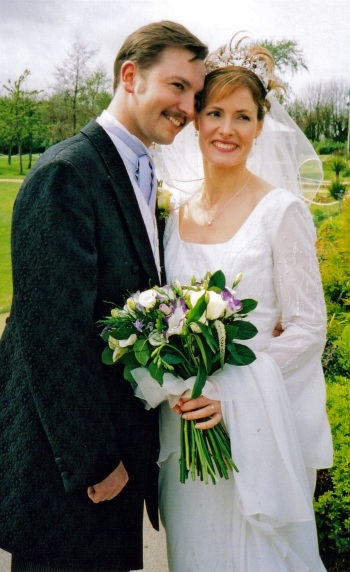
Canticle of Canticles (Song of Solomon) 2:10-11: Behold my beloved speaketh to me: Arise, make haste, my love, my dove, my beautiful one and come. For winter is now past, the rain is over and gone. When we were married on 27th April, 2002, Angie had these words inscribed on the front of the Mass booklets that she had designed and made for the guests to our wedding ceremony and Nuptial Mass. Â
With Thanksgiving
We give thanks to God for the fact that we were joined together in Holy Matrimony 15 years ago today. It is hard to believe that the time has gone by so fast!
We want to take this opportunity to again testify to the great beauty and graces of the Sacrament of Holy Matrimony, especially when it is consciously lived in and for Our Lord Jesus Christ.
The true teachings of the Catholic Church on Holy Matrimony were given by Christ; and it is from His Holy Spirit that they continue to receive their life-giving power today. Those clear teachings have been safeguarded and handed down from the Apostles. They may be found expressed with pristine clarity in the Sacred Scriptures and through a whole body of authorative teaching documents, such as: Arcanum Divinae;Â Casti Connubii;Â Humanae Vitae;Â Familiaris Consortio;Â The Truth and Meaning of Human Sexuality;Â The Catechism of the Council of Trent;Â The Catechism of the Catholic Church;Â and The Code of Canon Law.
These truths cannot be reduced to a mere ideal. In reality, they are the very essence of genuine marriage. They are the foundational bedrock of authentic living for God and one's spouse, the wellbeing of children, the strength of the Church and the health of society.
Christ's Truth Has Rescued Us and Given Us Life
By God's grace, it has been our experience as a married couple, that by rooting our lives in the revealed truths of the Catholic Faith, Our Blessed Lord has enabled us to become increasingly converted to Him; and to thus become ever more receptive to the graces and blessings He gives to help bring growth through the many hopes, joys, disappointments and sufferings of this passing world.
Without Christ and the grace He gives, we had only darkness and sin; with Him we have been given light and life.
As with all of the Sacraments of the Catholic Church, the Sacrament of Holy Matrimony is an efficacious sign that makes actual the thing which it signifies. This is why it makes no sense whatsoever for Modernists to attempt to sunder Catholic doctrine from pastoral practice.
Rooted in the sublime teachings of St. Paul in Ephesians 5, the Catechism of the Council of Trent authoratively teaches:-
For as marriage, as a natural union, was instituted from the beginning for the propagation of the human race, so was it subsequently invested with the dignity of a sacrament, for the procreation and education of a people in the religion and worship of the true God and of Christ our Saviour. For when Christ the Lord would give some sign of that very close union which subsists between Him and His Church, and of His boundless love towards us, He made known the dignity of so great a mystery principally by this holy union of man and wife; and the extreme aptitude of the illustration may be understood from this, that of all of human relations no one is more binding among men than the tie of marriage, and by it a man and woman are united in the closest bonds of affection and love. Hence it is that the Sacred Scriptures frequently place before our eyes, under the similitude of marriage, this divine union of Christ and His Church (Catechism of the Council of Trent, Part II, Chapter VIII, Question XV).
In light of these beautiful truths, regarding the very essence - rather than the mere ideal - of Holy Matrimony, it becomes even more clear why things like cohabitation, sexual activity outside of marriage, contraception, IVF, divorce/re-''marriage'' and homosexual activity offend against God and both the Natural and Divine Law; whilst in some sense also obscuring, or even wounding, the efficacious sign which Holy Matrimony gives to the world of God's Love.
The Gift and Challenge of Chastity
All people are called to live chastely and fulfill the requirements of chastity which accord with their given state in life. Due to the fallen nature of mankind, chastity is often both difficult and demanding. This is especially so in a society which has rejected God and scoffs at the very notion of chaste love. Nevertheless, chastity is no less beautiful for all of that.
We must never forget that, whilst chastity requires great effort and self-mastery, it is always primarily a work of God's free and unmerited gift of grace.
Our Lord Jesus Christ requires that His followers be chaste; at the same time, He gives them the means to accomplish that chastity.
It is the part of Catholics to willfully and humbly co-operate with that grace, through prayer, fasting, charitable acts and, above all, worthy, loving and frequent reception of the Sacraments of Holy Church.
St. Philip Neri used to teach that it was impossible to live chastely without Confession and the Holy Eucharist. St. Padre Pio spoke of these Sacraments as the medicine to withstand the contagion which increasingly surrounds us in these times. We need to receive Divine Love first, if we are then to be able to love ourselves, our spouses, our children and others beyond our families with the love of Christ. This is also where active devotion to Our Lady and St. Joseph play a key part.
Who among us can claim to have been truly chaste? Before the purity of Our Blessed Lord, most of us are, in varying degrees, just like the woman in the Gospel who was caught in the very act of adultery. And yet, Jesus has not condemned us. Instead, he has offered us forgiveness and instructed us firmly to sin no more. Further than that, knowing that we are made with clay, He has given us His teachings, sacraments, fellow Catholics, and the many other helps of Holy Church, to enable us to overcome our sins, receive healing and enter into the New Life in Christ.
This is why the heretical notion of ''gradualism'' is so cruel and evil. Like most heresies, it locks us in our own strengths - we had better to say weaknesses - and self-sufficiencies. It falsely suggests that we are OK as we are; as though God demands no more of us and would not provide further helps to us.
This is a travesty! Gradualism is a lie from the Devil and it leads to Hell. Have no part in it. It is a subtle denial of both our fallen nature, wounded as it is with Original Sin, Actual Sins and Concupiscent tendencies, as well as a denial of God's prevenient, accompanying and sacramental graces.
In contrast to the polluted milieu of the post-sexual revolution society in which most of us grew to adulthood, the Catholic Church's teachings and accompanying graces provide access to a perennial springtime of true love.
Like a lifeline, they rescue human personhood, dignity and the sexual faculty from the frozen winter of selfishness and hardness of heart, which presently engulfs society with a degrading swamp of lust, selfishness and sin, and instead sets them aright as warming lights on the mountain-top of self-sacrifical love.
As Christ shows us all from the Altar of the Cross, real love is that which selflessly seeks the good of the other, even to the point of ultimate self-sacrifice for their eternal wellbeing.
All of this comes as Christ's gift to the Church; and through Her to those that love Him. No wonder that the Devil and his minions want to destroy all of this in society, and even in the Church!Â
But as those words above remind us, taken as they are from the Canticle of Canticles 2:10-11, the present winter shall pass and the Love of Christ and His plan for human love will ultimately prevail in both Church and society. Because Christ lives, it cannot remain like a perennial winter, without the joy of Christmas, in some fictional Narnia forever. As we know from Christ's Glorious Resurrection: Love wins!
Christus Vincit! Christus Regnat! Christus Imperat!Â
Choose Life!
As we celebrate our 15th Wedding Anniversary today, please join us in praying for, and renewing our committment to, the grace of resisting all heresies against love, goodness, beauty and truth.
Let us ask Our Lord Jesus Christ, Our Blessed Lady and St. Joseph to help us to receive and co-operate with the graces needed to live with a pure heart. May we each love God, neighbour and ourselves with patience and true charity.
May we all begin again today to commit to being converted and living a New Life in Christ!
Please pray for the protection of our marriage and of the witness Christian marriage gives in today's Church and society.
We'll conclude today with a marvellous statement that the great St. John Chrysostom (349-407 AD), recommended for young husbands to say to their young brides.
Although we've gained a bit of weight and a few grey hairs - and in my case have managed to lose a few hairs too! - since these wedding pictures were taken 15 years ago, that great saint's words for newlyweds still seem appropriate for us to make our own again today.
I have taken you in my arms, and I love you, and I prefer you to my life itself. For the present life is nothing, and my most ardent dream is to spend it with you in such a way that we may be assured of not being separated in the life reserved for us... I place your love above all things, and nothing would be more bitter or painful to me than to be of a different mind to you.
May the Most Holy Family Pray For and Protect Our Marriage, the Marriages of All in the Lord and the Church's True Teachings on Chastity and Marriage. Wherever and Whoever We Are, May We All Choose this Day to Make a Renewed Committment to Chastity and to Live Lives of True Love in the Lord Jesus Christ. Amen!
Good Friday - Let us Compassionate and Love Our Saviour!
 Torch of The Faith News on Friday 14 April 2017 - 23:43:03 | by admin
Torch of The Faith News on Friday 14 April 2017 - 23:43:03 | by admin
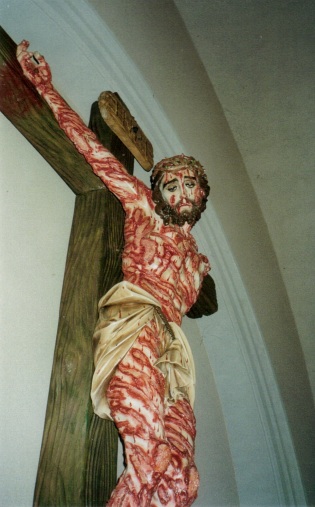
This is what sin does to Love! This is why we must all stop offending God, repent and be converted. This is why we have stood up to resist bad shepherds who promote heresies, the corruption of schoolchildren, sacrilegious Holy Communions, adultery, homosexuality, false religions and the dismemberment of the Church. Though perhaps, by nature, we would much rather had been silent and had a quiet life, this is why we were not so. In the end, it was a matter of love; for, as St. Francis of Assisi lamented: Love is not loved!
A Meditation by St. Alphonsus de Liguori
O my dear Redeemer! Well do I recognize in these Thy wounds, and in Thy lacerated body, as it were through so many lattices, the tender affection which Thou dost retain for me.
Since, then, in order to pardon me, Thou hast not pardoned Thyself, oh, look upon me now with the same love wherewith Thou didst one day look upon me from the Cross, whilst Thou wert dying for me. Look upon me and enlighten me, and draw my whole heart to Thyself, that so, from this day forth, I may love none else but Thee.
Let me not ever be unmindful of Thy death. Thou didst promise that, when raised up upon the Cross, Thou wouldst draw all our hearts to Thee. Behold this heart of mine, which, made tender by Thy death, and enamoured of Thee, desires to offer no further resistance to Thy calls. Oh, do Thou draw it to Thyself, and make it all Thine own.
Thou hast died for me, and I desire to die for Thee; and if I continue to live, I will live for Thee alone. O pains of Jesus, O ignominies of Jesus, O death of Jesus, O love of Jesus! Fix yourselves within my heart, and let the remembrance of you abide there always, to be continually smiting me, and inflaming me with love.
I love Thee, O infinite goodness; I love Thee, O infinite love. Thou art and shalt ever be, my one and only love. O Mary, Mother of Love, do thou obtain me love.
Our Lady of Sorrows - Pray for us!
St. Joseph - Pray for Us!
 Torch of The Faith News on Saturday 11 March 2017 - 23:29:40 | by admin
Torch of The Faith News on Saturday 11 March 2017 - 23:29:40 | by admin
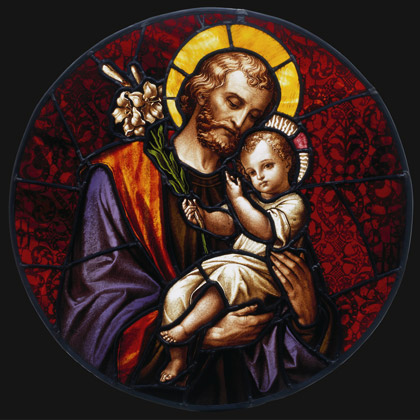
Remember that the St. Joseph Novena begins today, in preparation for the feast of the greatest of saints after Our Lady!
Behold Thy Mother! Remembering Our Lady's Maternal Love
 Torch of The Faith News on Sunday 12 February 2017 - 22:05:42 | by admin
Torch of The Faith News on Sunday 12 February 2017 - 22:05:42 | by admin
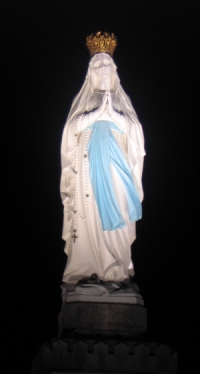
Superabundant Grace
Feasts like that of Our Lady of Lourdes serve as reminders of the superabundance of God's love, grace and mercy.
As is the case with so many Catholics, I can look back and give thanks for the many ways in which Our Lady of Lourdes has demonstrated Her maternal care in my own life.Â
Regular readers will recall that reading Fr. Gabriel Harty's simple little book Make the Wild Rose Bloom played a big part in my conversion story.
1992
My parents had both converted between 1989 and 1990. They were both praying for me to also convert when, in November 1992, I picked up Fr. Harty's book whilst I was watching a ''rock and pop awards'' show on TV. I suddenly experienced a gentle, yet very powerful, interior encounter with the love of Our Lady of the Rosary. As refreshing as a fall of dew on my soul, this experience caused me to find the noise and garish lights of the ''pop-culture'' to be no longer satisfying in comparison to the gentle peace and love of Our Lady of the Rosary. In fact, I now found them to be really dark and could not bear to watch the rest of that TV show.Â
Although this was not the only aspect of my conversion, it was a significant moment of grace, which led up to my reception into the Catholic Church at Easter 1993.
1997
I first went to Lourdes as a seminarian, in order to serve as a brancardier with the Liverpool Archdiocesan pilgrimage in July 1997.  Â
When we arrived, my friend Ron took me to the far side of the River Gave for my first-ever look at the Grotto from the vantage point pictured above.
Even from that range, there was an intensity of peace and holiness radiating out from the Grotto to where we were standing in silence. When I eventually turned to Ron, he just smiled and said: ''See what I mean?''
We recrossed the river and joined the long queue which was waiting patiently in the summer heat to enter the Grotto. When we finally entered that holy place, I rested my head against the cool Massabielle rock and looked up at the statue of Notre Dame de Lourdes. The ensuing peace cannot be described. I had a profound sense that, through all the years of my life, I had always been meant to come there at that particular time. It is hard to explain, but it was as though I had always been expected to be there just then.Â
The Motherhood of Our Lady was tangible.
 Â
Working for the sick, and seeing the hundreds of buggies, stretchers and wheelchairs laid out under the shade of the trees for the Blessing of the Sick with the Blessed Sacrament taught me the centrality in the Church of those who are sick, vulnerable and weak.
It is an indisputable fact of history, that no other single institution has cared for so many poor, sick, vulnerable and dying people, throughout so many cultures and historical periods, as the Catholic Church has done throughout her two millennia since Christ established her on earth. This alone remains an important facet of her claims to absolute truth.
At that point, I was in my mid-twenties. I had grown through my teens in ''Thatcher's Britain'' in the 80's and, prior to joining the seminary, had worked in a high-street bank for almost 9 years. For much of that time, I had aspired to the whole yuppie-culture. Although I had been a Catholic for 4 years by then, and had always been pro-life, I still needed to be weaned from my materialistic attachment to status, power and physical vitality.
There in Lourdes, kneeling before the Blessed Sacrament, near to row upon row of suffering and broken people who were waiting to receive Christ's blessing, Our Lady of Lourdes helped me to see that, in Christ's Kingdom, the elderly, suffering, poor and weak have a high place. Indeed, they are treated like royalty. Here we glimpse something of the mystery of the Church's rich Theology of the Cross.
1998
In the summer of 1998, I returned to Lourdes to serve for a whole month as a pilgrim-guide for English-speaking pilgrims. Â Â Â
Living and working so close to the Grotto for all that time was an immense blessing. In my whole life, I have never felt myself to be so emotionally, physically and spiritually healthy as I did in those weeks. I now realize that I was being built up for subsequent crosses!
The Maternity of Our Lady is indeed tangible.
That summer, Our Lady of Lourdes broadened my horizons to glimpse something more of the Catholic Church's universality.
Four whole weeks were spent living, praying and working with priests from France, Ireland and South Africa; and seminarians from Cameroon, France, Germany, Italy, Spain, the Netherlands and Vietnam. The international cameraderie was superb. In the above picture, I'm second from the left on the back row. The seminarian on the end in the white shirt had come through a simply amazing conversion experience. He is now Pastoor Nars Beemster; a splendidly orthodox Catholic priest serving in the Netherlands.
In the English-speaking section, I was assigned to serve pilgrims from the UK, Africa, America, Australia, India, Ireland, the Middle-East and the Philippines. It was great to feel oneself to be an active member of the Body of Christ in unity with Catholics from all of these disparate cultures. Â Â
During that month, several of the English dioceses came to Lourdes for their annual pilgrimages. I even unexpectedly met my own cousin in the Domain one evening! One day, I spotted the late Bishop Ambrose Griffiths of Hexham and Newcastle giving a blessing to the holy little gentleman pictured above. The humility and tenderness of that scene have always expressed something to me of the mystery of Our Lady of Lourdes and St. Bernadette.Â
As pilgrim-guides we: assisted people to find their way to Holy Mass, Confession and the baths; gave talks on the history of Lourdes; led groups in devotions up the steep hillside Stations of the Cross; led groups in the Blessed Sacrament and Torchlight Processions; and gave tours of the churches, museum and town.
During those weeks, my own faith was nourished and deepened by meeting so many faithful Catholics from all over the globe. Several had amazing stories of ''little miracles'' and blessings that had accompanied their pilgrimages. I met some amazingly humble and holy families from the Middle East and from the Kerala community in India. One of the most moving memories was of a young Australian ''surfer-dude'' and his girlfriend who came up to our English-speaking gathering point one day and asked, ''Hey mate, what is this place? Me and my girlfriend are back-packing across Europe. We just came out of the mountains and we've never seen anything like it. It's just amazing!'' It was marvellous when this wide-eyed couple joined us in the Blessed Sacrament Procession that afternoon. May God bless them, wherever they are now.
Although my faith was strengthened that summer, I also began to sense that I may, after all, be called to Holy Matrimony, rather than to the Sacred Priesthood. Although this was profoundly unsettling, especially in such a blessed place, I can now see that Our Lady was guiding me and looking after me all the time.
1999
In the summer of 1999, I returned to Lourdes with Mum and Dad for a very different type of pilgrimage: this time I was not there to work, but to receive. I was reaching the point where I was really sensing that marriage was to be my vocation. On top of that, the culture of sacrilegious irreverence and radical dissent in the seminary had wrecked my health and caused me to crash and burn. Big time...
During our stay in Lourdes, a devout old Irish lady sat by us at breakfast in our hotel. She noted quietly to me that she could see that my face was smiling, but my eyes were very sad. She asked if I had ever been training to be a priest. Amazed at her discernment, I agreed to let her pray for me and tell me her own story.
It turned out that, many decades earlier in Ireland, she had tried her vocation in a convent. During her postulancy, it had become clear to her that God wanted her to marry instead. She had to suffer a great deal for a while and few in her family or local town understood her decision. She persevered in her prayer life and, after a few years, met her devout Catholic husband. They married and went on to have several children and many grandchildren. With her husband, she devoutly practiced the Faith for about 50 years. Indeed, this lady said to me: ''Look how many children I now have to give to God!'' She told me to have great trust in the Lord and assured me of her ongoing prayers. Â Â
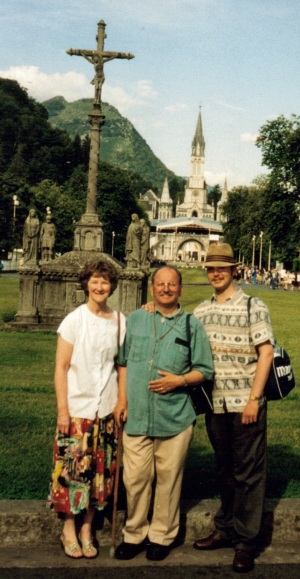
Although this was a pilgrimage marked by deep interior suffering, it was also very beautiful to be able to show Mum and Dad all the places and things that I had shown to pilgrims the year before. This was the only time that Dad ever travelled overseas in his whole life. May God rest his soul, he was faithful to his Rosary for all the years he was a Catholic. At the very end of our pilgrimage, we went for a final prayer at the Grotto, before heading off to Tarbes airport. At the Grotto, I received a very clear and tangible direction regarding my vocation. Although I had to process this, through several more weeks of pacing Crosby beach every day with Dad when we got back home, that moment at the Grotto was important.
Yes, truly the Maternal protection of Our Lady is tangible!
I wrote to Archbishop Patrick Kelly of Liverpool and he accepted my decision with kindness and a supportive letter. His Grace's letter included a reference to Blessed Cardinal John Henry Newman's Lead Kindly Light. As this had already played an encouraging role in my personal struggles in those months, I took this as a sign of confirmation and that part of my journey came to an end. It was the last part of the summer of 1999.
2008
Those who know us will recall that I met Angie at the wedding of a mutual friend in August 2000. Actually, she caught the bouquet! By God's grace, we had each found our soul-mate in Christ and we were married by Canon Albert Shaw on Merseyside in April 2002.
Six-and-a-half years after we got married, we suddenly had the chance of a last-minute booking to go to Lourdes for the Feast of the Immaculate Conception in December 2008. This would be my fourth visit to the holy shrine; but my first as a married man. Â Â
It turned out to be a time of special blessings for us. When the great feast day was over, the town and shrine of Lourdes basically shut down for the winter season.
As the crisply cold winter air settled over the French Pyrenees, most people departed for warmer climes. This meant that, unlike in the buzy and hot summer months of all my previous visits, we were able to return again and again to the Grotto, without having to queue at all. Indeed, apart from some French schoolgirls singing beautiful chants by candlelight, there was hardly anybody else around.
Having helped us in so many ways, it now seemed that Our Lady of Lourdes was helping us to recognize the great value in withdrawing from the crowd and bustle, in order to enter into the Great Silence.
Yes, the Maternity of Our Lady of Lourdes is truly tangible!
Over to You!
I pray that whoever reads this, be you Catholic or not, will be able to go to Lourdes and experience these things first hand. Even if you cannot get there, the love of Our Lady is already there for you from Heaven. All you really have to do is open your heart and pray.
Our Lady of Lourdes - Pray for us!
St. Bernadette Soubirous - Pray for us!Â




